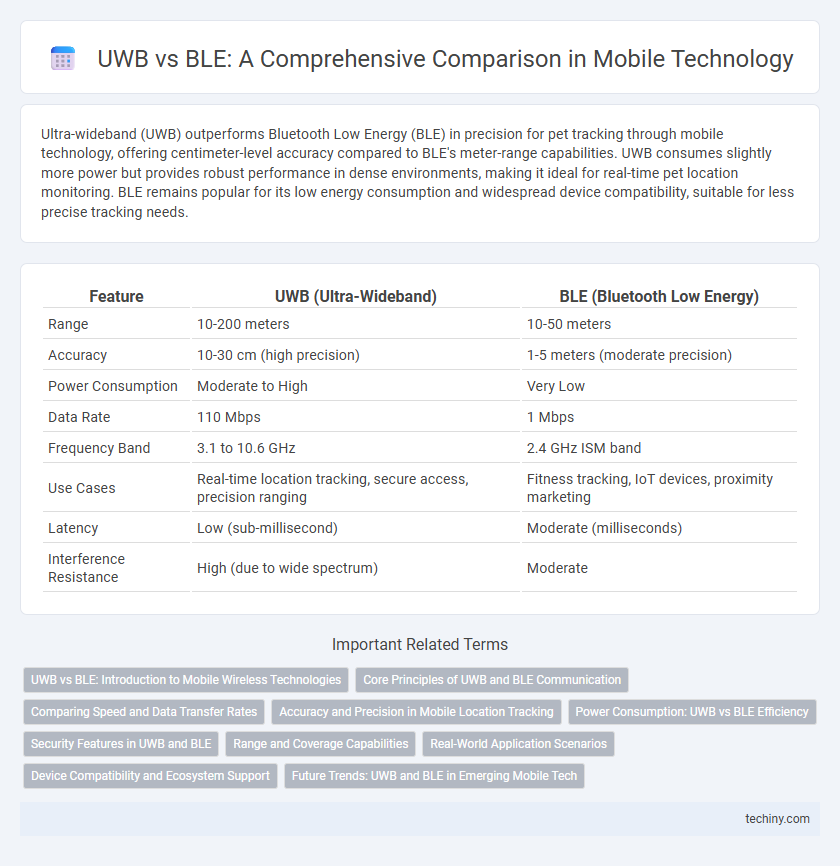Ultra-wideband (UWB) outperforms Bluetooth Low Energy (BLE) in precision for pet tracking through mobile technology, offering centimeter-level accuracy compared to BLE's meter-range capabilities. UWB consumes slightly more power but provides robust performance in dense environments, making it ideal for real-time pet location monitoring. BLE remains popular for its low energy consumption and widespread device compatibility, suitable for less precise tracking needs.
Table of Comparison
| Feature | UWB (Ultra-Wideband) | BLE (Bluetooth Low Energy) |
|---|---|---|
| Range | 10-200 meters | 10-50 meters |
| Accuracy | 10-30 cm (high precision) | 1-5 meters (moderate precision) |
| Power Consumption | Moderate to High | Very Low |
| Data Rate | 110 Mbps | 1 Mbps |
| Frequency Band | 3.1 to 10.6 GHz | 2.4 GHz ISM band |
| Use Cases | Real-time location tracking, secure access, precision ranging | Fitness tracking, IoT devices, proximity marketing |
| Latency | Low (sub-millisecond) | Moderate (milliseconds) |
| Interference Resistance | High (due to wide spectrum) | Moderate |
UWB vs BLE: Introduction to Mobile Wireless Technologies
Ultra-Wideband (UWB) and Bluetooth Low Energy (BLE) are prominent mobile wireless technologies distinguished by their communication ranges and data transfer capabilities. UWB excels in precise spatial awareness and centimeter-level accuracy for location tracking, making it ideal for applications like secure access and indoor navigation, while BLE offers low power consumption and widespread compatibility for continuous device connectivity and IoT ecosystems. Comparing frequency bands, UWB operates in a wide spectrum around 6-8 GHz, enabling high bandwidth and minimal interference, whereas BLE functions in the 2.4 GHz ISM band, prioritized for energy efficiency and cost-effectiveness.
Core Principles of UWB and BLE Communication
Ultra-Wideband (UWB) communication uses short pulses across a wide frequency spectrum to achieve precise ranging and high data rates with low power consumption. Bluetooth Low Energy (BLE) operates on a narrow band with frequency hopping spread spectrum, optimized for low energy consumption and intermittent data transfer. UWB excels in accurate spatial awareness and real-time location services, while BLE is widely adopted for continuous device connectivity and multi-vendor interoperability.
Comparing Speed and Data Transfer Rates
Ultra-Wideband (UWB) offers significantly higher data transfer rates, reaching up to 27 Mbps, compared to Bluetooth Low Energy (BLE), which typically maxes out at 2 Mbps. UWB's wide frequency spectrum allows for faster and more precise data transmission, enabling enhanced real-time applications such as asset tracking and indoor positioning. BLE prioritizes low power consumption over speed, making it ideal for periodic data exchange but less suitable for large or high-speed data transfers.
Accuracy and Precision in Mobile Location Tracking
Ultra-Wideband (UWB) technology offers significantly higher accuracy and precision in mobile location tracking, providing centimeter-level resolution compared to Bluetooth Low Energy's (BLE) meter-level accuracy. UWB leverages wide frequency bands and time-of-flight measurements to deliver precise spatial data, making it ideal for applications requiring exact positioning. BLE, while more energy-efficient and widely adopted, relies on signal strength indicators that result in less precise location tracking, often leading to larger positional errors.
Power Consumption: UWB vs BLE Efficiency
Ultra-wideband (UWB) technology offers higher precision in location tracking while consuming more power compared to Bluetooth Low Energy (BLE), which is optimized for minimal energy usage in continuous connectivity. BLE typically operates at milliwatt power levels, making it more suitable for battery-powered mobile devices requiring prolonged operation. UWB's power consumption can be several times higher during active transmission, limiting its use to scenarios where pinpoint accuracy outweighs energy efficiency.
Security Features in UWB and BLE
Ultra-Wideband (UWB) offers enhanced security features such as precise spatial awareness and resistance to spoofing attacks, making it ideal for secure device positioning and access control. Bluetooth Low Energy (BLE) employs AES-128 encryption for data exchange but is more vulnerable to passive eavesdropping and relay attacks due to its broader signal range. UWB's frequency hopping and short pulse duration provide stronger protection against interception compared to BLE's longer transmission intervals.
Range and Coverage Capabilities
UWB (Ultra-Wideband) offers precise ranging capabilities with an effective range of up to 30 meters, providing centimeter-level accuracy ideal for indoor positioning and secure device-to-device communication. BLE (Bluetooth Low Energy) supports longer coverage distances, typically extending up to 100 meters, making it suitable for broad area connectivity but with less precise location tracking. UWB's short range and high accuracy complement BLE's extended reach, enabling optimized mobile technology solutions depending on application requirements.
Real-World Application Scenarios
Ultra-Wideband (UWB) excels in precise indoor positioning and secure access control, supporting applications like smart car keys and asset tracking with centimeter-level accuracy. Bluetooth Low Energy (BLE) dominates in low-power, long-range communication ideal for fitness trackers, smart home devices, and proximity marketing. Real-world scenarios favor UWB when accuracy and security are critical, while BLE suits energy-efficient connectivity in consumer wearables and IoT ecosystems.
Device Compatibility and Ecosystem Support
Ultra-Wideband (UWB) technology offers precise spatial awareness and secure device interaction but currently has limited device compatibility compared to Bluetooth Low Energy (BLE), which enjoys widespread integration across smartphones, wearables, and IoT devices. BLE's mature ecosystem supports millions of devices with robust cross-platform interoperability and low power consumption, making it ideal for broad connectivity applications. UWB's growing adoption in premium devices is enhancing ecosystem support, yet BLE remains dominant due to its extensive developer tools and established market presence.
Future Trends: UWB and BLE in Emerging Mobile Tech
Ultra-Wideband (UWB) and Bluetooth Low Energy (BLE) are shaping the future of mobile technology with UWB offering high precision ranging and secure device localization, essential for applications like contactless payments and augmented reality navigation. BLE remains critical for low-power, long-range connectivity in wearable devices and smart home ecosystems, ensuring sustained energy efficiency and interoperability. Emerging trends indicate UWB integration within smartphones combined with BLE's widespread adoption will drive enhanced context-aware services, seamless device interactions, and improved spatial awareness in next-generation mobile experiences.
UWB vs BLE Infographic

 techiny.com
techiny.com